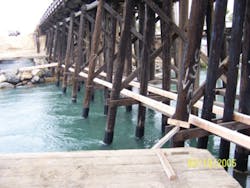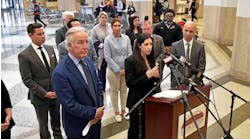Trains are again contenders in the mass transit game, competing for both passengers and freight. Planes once soared above, but steep fuel costs and airport hassles have made for turbulent times. Trains, on the other hand, are now more energy efficient, use less fuel than planes, and do not come with the many hassles associated with airports (such as airport security and long lineups). Amtrak, in 2012, carried over 31 million passengers, the most in a single calendar year in its history. Ridership has doubled since 2000, and Amtrak expects the growth trend to continue.
One of the major, foreseeable impediments to growth is rail infrastructure. The classic railroads of yore cannot handle the surging ridership. Many of them already handle freight. The demand exceeds capacity, forcing bottlenecks to occur. The solution for many railroads is easy to conceptualize but hard to execute: adding a second train track or “double track.” In some cases, a third or fourth track should be added, like the line from Philadelphia to Baltimore or from Washington, D.C. to Baltimore. Adding tracks has proven to be a winning solution in most bottlenecking problems. Most bottlenecking occurs because trains have to stop and take turns using the same track. An additional track allows trains to continue moving past each other and increases routing options.
The interrelationship between passenger and freight train services motivates both industries to invest in railroad infrastructure upgrades. Many passenger trains, including those that Amtrak operates and those that other commuter companies operate, run along existing freight lines. Passenger and freight trains compete for precious track time. Passenger train delays contribute to freight train delays and vice versa. The opposite is also true. Passenger train efficiencies contribute to freight train efficiencies and vice versa. Thus, both the passenger and freight train industries have been investing in railroad infrastructure upgrades, specifically to train tracks, bridges, and tunnels. In fact, both industries combined have invested over $75 billion since 2009. The upgraded infrastructure, in turn, improves the capacity and reliability of on-time service to both passengers and freight.
The state of California is a representative case study. The Los Angeles to San Diego (LOSSAN) rail corridor is Amtrak’s second busiest rail corridor in the U.S. As such, the LOSSAN rail corridor is the target of a multimillion-dollar upgrade project designed to improve the capacity and reliability of on-time passenger and freight train services. The first phase is in Carlsbad, San Diego County, CA, called the Carlsbad Double Track and Bridge Project.
The purpose of the Carlsbad Double Track and Bridge Project is to improve the capacity and reliability of on-time passenger train service along the Carlsbad portion of the LOSSAN corridor. The problematic bottleneck was the single main train track at Carlsbad Poinsettia Station. The solution was to create two main tracks, each 5.1 miles long, by extending an existing second main track 1.9 miles.
Challenge 1: Spanning the Agua Hedionda Lagoon
Projects of this scale and magnitude face a multitude of complex engineering challenges. At Carlsbad, the major challenge is spanning water, specifically the Agua Hedionda Lagoon.
The Carlsbad Double Track and Bridge Project is not the first to span the Agua Hedionda Lagoon.
- 1881: The first railroad bridge across the lagoon is the California Southern Railway, a subsidiary of Atchison, Topeka & Santa Fe (AT&SF) Railway. The bridge is a classic trestle, a series of short spans across a number of supports, and reflects the early trend of railroading. The trestle has 14 spans with a ballasted deck, where the rail track fastens directly to ties on the spans. The trestle support posts are pile-driven into the ground. In short, the bridge is a 14-span open-deck pile trestle bridge.
- 1948: AT&SF field records indicate a third timber trestle in a new alignment.?
- 1958: The City of Carlsbad adds a 12-inch sanitary sewer timber pile trestle bridge across the creek adjacent to the timber trestle on the inland side.
- 2006: North County Transit District (NCTD) builds a three-span concrete bridge on a new alignment west of the 1948 timber trestle, meant to replace the trestle. They demolish the timber trestle to accommodate a future second main track or “double track.”
- 2009: Amtrak issues a design contract for the Carlsbad Double Track and Bridge Project.
- 2010: Amtrak issues a construction contract for the Carlsbad Double Track and Bridge Project.
- 2012: The Carlsbad Double Track and Bridge Project finishes and both main tracks are open for revenue-generating train service.
The two main tracks stand side by side across the Agua Hedionda Lagoon, exhibiting the next evolution of bridge design:
Developing the Girders
The first concrete bridge (2006) has spans made from standard concrete bulb-tee girders, which are beams that look like elongated “I” letters. The girders, four per span, support a ballast bridge deck, where the train track fastens to ties that are in a bed of stable ballast material on top of the bridge deck. The outermost girders on both sides support the ballast retainers.
The structural bridge designer on the Carlsbad Double Track and Bridge Project makes a unique design improvement. He notices that two different components of the 2006 concrete bridge perform the same function. Why not eliminate one? He decides to eliminate the separate bridge deck altogether from the new concrete bridge. He redesigns the standard bulb-tee girders, widening and thickening the top edges. The redesigned top edges now support the ballast directly, eliminating the need for an intermediate bridge deck.
As before, the outermost girders on both sides support the ballast retainers. The short girders have the ballast retainers precast, and the long girders have the ballast retainers cast in place after setting.
The redesigned bulb-tee girders are the highlight of the Carlsbad Double Track and Bridge Project, saving about $750,000 of construction costs and two months of construction time. The savings are the estimated construction costs and time of building a separate bridge deck. As a result, the overall project is under budget and ahead of schedule.
Developing the Piles
The 2006 concrete bridge has conventional cast-in-drilled-hole (CIDH) pile supports, which are concrete piles cast in holes drilled to predetermined depths. Whenever drilling in any scenario occurs, the surrounding ground moves and the ground level shifts. The ground level also shifts naturally from soil movement or volume changes. The bridge structure and train track may displace if the ground level shifts too dramatically. To mitigate this risk, the 2006 bridge team made ground modifications prior to drilling.
However, the modified drilling still caused a number of environmental changes, most notably ground movement and soil liquefaction. In turn, the track on the adjacent 1948 timber trestle displaced (which the Carlsbad Double Track and Bridge Project has now replaced). To further complicate matters, the geotechnical evaluation concluded that the loose soil in the area could potentially liquefy below the water table, which is the imaginary line separating ground saturated with water and unsaturated ground. The soil, sediment, and rocks are full of water below the water table.
The Carlsbad Double Track and Bridge Project designer has to determine a safe way to install the substructure piles at the timber trestle’s location. The designer has to consider various pile installation methods. From history, he knows that the drilling method, even with ground modifications, does not work. From the geotechnical evaluation, he knows that the driving, boring, and vibrating methods would not work because they cause high water table and the risk of more soil liquefaction. The designer, through process of elimination, decides to use the oscillating method.
For added stability and strength, the designer uses cast-in-steel-shell (CISS) piles instead of CIDH piles. CISS piles are steel tubes filled with concrete. Each intermediate pier uses two larger diameter CISS piles, while each abutment uses two smaller diameter CISS piles. To stabilize the earth, the designer uses auger cast concrete piles, installed seven days before the CISS steel tubes. The tube installation process does not cause or encounter any significant ground movement or soil liquefaction. A concrete pump truck fills all of the CISS steel tubes with concrete.
During pile installation, temporary sheet shoring protects the 2006 concrete bridge and track from collapse and other disruptions. The protective measure allows the train service to continue amid construction of the new intermediate piers and abutments.
Two cranes, at either end of the bridge, set the redesigned girders onto the new intermediate piers and abutments. The bridge deck (the top edges of the redesigned girders) is waterproofed and flooded with ballast material. The train track fastens to the ballast ties.
Challenge 2: Maintaining Existing Train Service
The design of the train track itself is an ordinary fare. The challenge is developing a new track alignment while maintaining existing train service. The alignment would need to accommodate a second main track, a second main bridge, and a universal crossover control point that allows trains to switch tracks when traveling in either direction.
The universal crossover does not make use of the existing turnout or switch, relying instead on four newly installed turnouts. The train service could continue on the existing turnout.
The railroad at Carlsbad operates according to the General Code of Operating Rules (GCOR), a compilation of operating rules for some railroads in the United States. The GCOR allow crew to perform track work that passing trains would otherwise disrupt, as long as certain conditions are met. The Carlsbad Double Track and Bridge Project secures Form B protection, which allows construction to occur between trains with the use of flags for protection. Form B protection proves to be the most cost effective for the majority of work.
Challenge 3: Considering the Whole System
The new track passes over three existing grade crossings: Tamarack Avenue, Cannon Road, and a private power plant grade crossing. They all require new crossing warning devices.
The new universal crossover requires new control point signals, intermediate signals, and switch machines.
The footprint of the new track requires a retaining wall. The first segment of the wall is a post and panel design, and the second segment is an environmental concrete block design.
The Carlsbad Double Track and Bridge Project achieves its specific performance purpose, while also being under budget and ahead of schedule. However, a less touted fact that has significant relevance is that the project has no injuries or accidents. The push for performance metrics becomes moot if it comes at a human cost. The Carlsbad team, being dedicated and committed to the project, recognizes and emphasises safety. Ensuring the safety of everyone involved is an aspect of effective project and construction management. Going forward, other projects would benefit from continuing this emphasis on safety.
Evaluating the Project Outcome and Future Trends
The purpose of the Carlsbad Double Track and Bridge Project is to improve the capacity and reliability of on-time passenger train service along the Carlsbad portion of the LOSSAN corridor. The problematic bottleneck was the single main train track at Carlsbad Poinsettia Station. The solution was to create two main tracks, each 5.1 miles long, by extending an existing second main track 1.9 miles.
Amtrak made a decision and recent announcement that are testaments to the success of the Carlsbad Double Track and Bridge Project. Before the project, only NCTD’s Coaster commuter trains stopped along the Carlsbad portion of the LOSSAN corridor. After the project and effective on Oct. 7, 2013, Amtrak has added its service with four new station stops between San Diego and Oceanside. The new stops are at Sorrento Valley, Encinitas, Carlsbad Poinsettia, and Carlsbad Village. Amtrak’s Pacific Surfliner trains are servicing these stops, with three northbound trains and three southbound trains every day of the week. The addition of Amtrak gives passengers another travel option in the Carlsbad area. NCTD still runs its Coaster commuter train.
The next project in San Diego County is the Carlsbad Village Double Track, which further extends the just completed Carlsbad double track 1.1 miles north through Carlsbad Village Station, across Buena Vista Lagoon, and up to southern Oceanside. The Carlsbad Village Double Track, when joined to the existing 2.4-mile double track at Oceanside, will create 8.6 miles of uninterrupted double track.
The purpose of the Carlsbad Village Double Track Project is to further improve the capacity and reliability of on-time passenger train service along the Carlsbad portion of the LOSSAN corridor. The problematic bottleneck now is the single main train track at Carlsbad Village Station. Trains currently have to stop and take turns using the single main track. The solution is to create two main tracks through the Carlsbad Village Station by extending the just completed second main track at Carlsbad Poinsettia Station.
The Carlsbad Village Double Track Project will comprise a second main track, a second main bridge across Buena Vista Lagoon, and upgrades to the Carlsbad Village Station such as a pedestrian underpass. The new track passes over two existing grade crossings: Carlsbad Village Drive and Grand Avenue. They both require safety improvements.
The San Diego Association of Governments (SANDAG) has a comprehensive plan for the long-term improvement of the 60-mile San Diego County segment of the LOSSAN rail corridor. The $800 million, 20-year plan has 19 rail projects under development, with 15 of them already funded. To compare, the Carlsbad Double Track and Bridge Project cost $18.4 million in total, and the Carlsbad Village Double Track Project has an almost $6 million design fund (the construction has not been funded yet). The main action of the plan is to double track from Downtown San Diego north to the Orange County line. Over 97% of San Diego County’s LOSSAN corridor will be double-tracked at plan’s end, up from 50% at present. The next five years will see about 11 new miles of double track. The plan also includes replacing old track and bridges, building new train station platforms and passenger underpasses, and building or upgrading any necessary equipment.
The main purposes of SANDAG’s plan are many:
- Increase passenger and freight train services to meet future demands
- Increase reliability of the whole rail system
- Decrease travel time for passengers
- Increase movement of freight
- Provide an alternate transportation method to the heavily congested Interstate 5 highway, for both passengers and freight
SANDAG knows the importance of continuous investment in rail infrastructure. The first main train track in San Diego County’s LOSSAN corridor is over 100 years old. Even if one track provided enough capacity to meet the demands, the age of the track still necessitates continual upgrades. Because one track is not enough to meet current and future demands, the long-term strategy is clear. About 50% of San Diego County’s LOSSAN corridor has been double-tracked in the last 100 years. The double track not only increases capacity but also allows old track to be replaced without seriously disrupting train service.
The enhanced LOSSAN corridor will also help facilitate high-speed trains, the next generation of track transportation. California has a new high-speed train system in the works, which will share parts of the LOSSAN rail corridor.
John Eschenbach is a Senior Project Manager at J.L. Patterson & Associates, a Southern California-based trackwork engineering firm that spearheaded the inventive engineering of the Carlsbad Double Track. He has more than 37 years of experience in the design, maintenance and construction management of class I railroads. He can be reached by email at [email protected].



